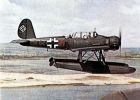
ARADO AR 1961764 viewsthe Ar 196's primary duties consisted of reconnaissance and shadowing of service vessels. While in most respects the Ar 196 is not a formidable aircraft, for a seaplane it's performance exceeded it's Allied counterparts. After Germany's capital ships ceased active participation in the war, most Ar 196's were relegated to sea patrols from shore bases. About 50 planes served with Balkan air forces in the Adriatic and Black Sea.
Variants:
Ar 196A-0, Ar 196A-1, Ar 196A-2: Coastal patrol variant.
|
|
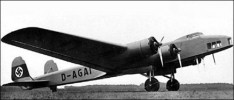
Dornier Do 191255 viewsAlong with the Junkers Ju 89, the Do 19 was developed as part of the "Ural Bomber" program championed by Gen. Walther Wever who forsaw the need for long range strategic bombing capability. When Gen. Wever was killed in April of 1936, the goal of a strategic bombing capability died with him. On April 29, 1937, the Ural-Bomber bomber program was cancelled by Kesselring in spite of protests. Kesselring felt the production and development resources would be better used to develop and build tactical bombers such as the Do 17 and He 111. This philosophy would later haunt and severely handicap the Luftwaffes ability to strike at Russia's production capabilities.
|
|
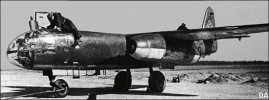
Arado Ar 2401178 viewsThe German Arado 234 was the very first purpose-built jet bomber. While the Ar-234 had very little influence on the outcome of World War II, being much too late and too few in number, it had influence on later aircraft designs. The Ar-234B could be configured either as a bomber or reconnaissance aircraft. It weighed about 5.2 tonnes (11,464 pounds) empty, and about 8.43 tonnes (18,850 pounds) fully loaded. Maximum bomb load was about 1.5 tonnes, carried externally. When used as a reconnaissance aircraft, the AR-234B carried a pair of 300 liter (79 US gallon) drop tanks in place of the bombs.
The powerplants consisted of a pair of Junkers Jumo 004B turbojets, with 900 kilograms (1,980 pounds) thrust each. Maximum speed without bombs or drop tanks was 740 KPH (460 MPH) at 6,100 meters (20,000 feet), but the speed dropped to as low as 660 KPH (410 MPH) with external loads. The prototypes had actually been a good 30 KPH faster than the Ar-234B, due to the more slender fuselage allowed by the lack of landing gear. Tricycle landing gear was fitted. As the Ar-234 landed at high speed, it had a drag chute as standard equipment; it was one of the first aircraft to do so. The rounded nose of the aircraft was covered with plexiglas, giving the pilot an excellent view to the front, but no view to the back except through a periscope. The periscope, which was not provided in the Ar-234 prototypes, also served as a sight for dive-bombing attacks. As a bomber, the Ar-234 was something of a failure. It could not carry enough of a bombload to match the destructive power of the big heavy bombers that were smashing the Reich. However, as a reconnaissance aircraft it proved able to bring back intelligence from airspace denied to prop-driven aircraft.
There were also a number of innovations in the Ar-234 that would be seen in later aircraft.
|
|
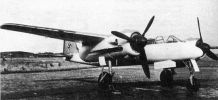
Focke Wulf TA154 Moskito1133 viewsThe Ta154 was developed because the Mosquito night bombers were almost invulnerable for a long time. The airframe was made of wood, a quite unusual feature for a german frontline aircraft, and there was just one production plant for a suitable glue, which was destroyed by a bombing raid. Instead, another glue was used, which caused some damage to nearby wood. This was the reason why Tank cancelled the quantity production after 8 prototypes, 7 pre-serial planes and only 10 serial planes until a better glue was available (indeed, there was none). Another weakness was the bow-wheel landing gear, which caused some crashes. Interesting was the method how the stability of the structure at high speeds was tested; they dragged a hull through water at high speed! The Ta154C was supposed to make use of the modern 1750PS Jumo213 engines.
|
|
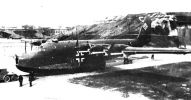
Blohm und Voss BV 222977 viewsWith a wing span of 46 m and six engines the Blohm & Voss BV 222 was the largest flying boat built in the second world war. On 7th August 1941, the BV 222 V2 which, following experience with the V1, was already equipped with suitable defensive weapons, made it's maiden flight. The first flight took place on 7th September 1940, which was after the start of the second world war, when a machine with a long-range capacity and large cargo space was already of special interest to the military. A total of 12 machines were built in different versions. After completion of trials and conversion, the V2 went into service as a troop transporter with LTS See 222 (air transport command sea 222), before it was finally introduced to 1/SAGr. 129 in Biscarosse, France for the long-range reconnaissance purpose for which it was originally intended.
|
|
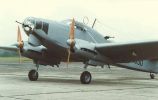
Focke-Wulf Fw 58832 viewsThe Focke-Wulf Fw 58 was an excellent aircraft. It made its first flight in 1935 as a six-seat light transport. The prototype, Fw 58 V1, first flew in 1935 as a six-seater transport. The second prototype was in military guise, having machine guns fitted both in the nose and dorsally. The next production run was of the Fw 58B, some of which were bombers and some others being fitted with floats - the Fw 58BW. The main production model was the Fw 58C, a light transport. Eight were delivered to Lufthansa during 1938/9 as commercial transports.
Large numbers of bothe Fw 58Bs and Fw 58Cs were used by the Luftwaffe being used for light transport, communications and ambulance duties in large numbers even, on occasions, for crop spraying.
|
|

Messerschmidt Me 410 Hornisse780 viewsThe Me 410, was an improvement of the Me 210 proposed as a high altitude fighter/bomber with two DB 603A engines (1750 hp), wing edge slats, a presurized cabine, lengthened engine nacelles and no sweep back on the wings. The Me 410 was waited everywhere in all fronts by 1943 and arrived too late. When it finally arrived, it was usually limited to the role of high-speed bomber or reconnaissance. The Hornisse was more successful in Observation units 1 and 7 than in the interceptor role.
The first prototype V1 was ready by the end of 1942. The entire test program envolved some twenty test planes many of which were modified Me 210s. The armament was the same as in the Me 210.
|
|
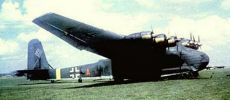
Messerschmitt Me 323759 viewsA powered derivative of the Me 321, the Me 323 proved to be a successful aircraft. Several variants were produced including a Gunship and bomber. This vulnerable transport suffered heavily at the guns of Allied fighters. This version also carried several tonnes of armor and bulletproof glass. Eventually it was decided that escort fighters would be more effective and this version did not see wide-spread production.
|
|
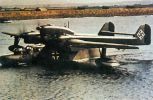
Blohm und Voss BV 138724 viewsThe first prototype which was ready in July 1937 had seveare problems in the air and on the water. A general re-design of the construction followed. Some BV 138 A's were used as transporters for the norwegian campaign in 1940, but late in June 1941 the BV 138 B's saw their service in the role they were constructed for, as sea-reconnaissance planes. From then on they patroled the North-sea and the Arctic-sea and shadowed the well known North-Cape convoys.
The version BV 138 MS was equipped with a mine-sweeping gear and the BV 138 C-1 which was equipped with Radar saw service in anti U-boat attacks.
|
|
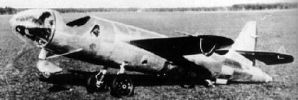
Heinkel He 176705 viewswas the world’s first aircraft to be propelled solely by a liquid-fuelled rocket, making its first powered flight on July 20 1939 with Erich Warsitz at the controls. The He 176 was built to utilise one of the new Walter engines. It was a tiny, simple aircraft, built almost entirely out of wood and lacking even an enclosed canopy. It had a conventional, fixed, tricycle undercarriage, but relied on the weight of the pilot to actually rest on its wheels. Empty, the tail of the plane rested on the ground. Heinkel demonstrated the aircraft to the RLM, but official disinterest led to the abandonment of the company's rocket propulsion programme. The He 176 was placed in the Deutsches Technikmuseum ("German Technical Museum") in Berlin, where it was destroyed in an air raid during World War II.
|
|
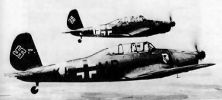
Arado Ar 96686 viewsAdvanced trainer monoplane. At least 11546 built during WWII, and production continued in Czechoslovakia until 1948.
Type: Ar 96B-5
Function: trainer / liaison
Year: Crew: 2 Engines: 1 * 360kW Argus As 10MA-1
Speed: 330km/h Ceiling: 7000m Range: 990km
Armament: 1*mg7.9mm
|
|
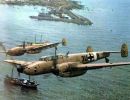
Messerschmitt Bf110670 viewsWilly Messerschmitt however made a creditable attempt with the Bf110, resulting in a machine at that time faster than the Bf109 and similar in speed to the Hawker Hurricane, (end of 1936).
The Bf110 was also tried as a bomber and a night fighter, the latter being its more successful role.
But it must be said that long range, speed, and manoeuvrability, are not mutually compatible and the Bf110 never was more than a maid of all work.
|
|
|
|